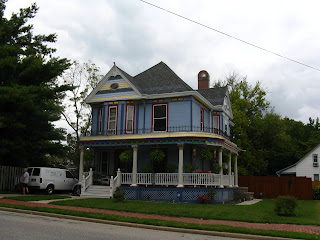
Grafton, Illinois was our first stop on the Mississippi. We spent a couple nights there eating out and walking through downtown.
As we headed down the Mississippi there were bluffs on the east side.
You may have to click on this picture to enlarge it but there is a fellow canoeing down the Mississippi. We saw him again a couple days later. I'm not sure how far he was going but he had tents and supplies with him so he was having an adventure.
Alton, Illinois was a larger city on the Mississippi. I skipped the gambling casino on the river and took my folding bike downtown to check out some of the historical and architectural sites.
Alton was the birthplace of the world's tallest man, Robert Wadlow (8'11.1"). Coincidentally, a few weeks earlier we had visited the town where he died of a baterical infection from a blister on his foot - Manistee, Michigan. He is buried in Alton.

Anything Lincoln did in Illinois is documented and has a plaque. Lincoln gave a political speech at this building and since he knew the owner probably used the building for attorney duties in the 1840's and later.
Alton also was the site of a Lincoln Douglas debate and had a prison that held Confederate Prisoners during the Civil War.

Further up the hill from the river I found several Victorian homes. Some with plaques and some recently refurbished like this one.

About a mile south of our marina in Alton was the Melvin Price Lock and Dam. The locks had an excellent visitor center called the National Great Rivers Museum. The exhibits used videos, sand models and displays to explain the creation of rivers and how they are managed now to provide multiple uses including maintaining navigable depths for commercial traffic. The system of diversion dams and weirs along the Mississippi river serve to help the current flush out sediment and keep the main channel at desired depths.
One of the neatest exhibits was a simulation of driving a tow boat to maneuver barges into a lock, or through bridges. With hands on controls it was pretty realistic.

We left the Alton marina on September 24th. It was overcast with some sprinkles as we approached our first Mississippi lock, the Melvin Price lock. We had to wait about a half hour to get in so we dropped an anchor to hold us in place while we waited.
 There are actually two Melvin Price lock. One is 1,200' long by 110' wide and a shorter auxiliary lock. We had to wait for a tow to clear the main lock before we entered. The gate is the type that raise up from under the water to close off the end of the lock. i.e. a vertical lift gate. We seemed like a small cork in the huge expanse of this lock.
There are actually two Melvin Price lock. One is 1,200' long by 110' wide and a shorter auxiliary lock. We had to wait for a tow to clear the main lock before we entered. The gate is the type that raise up from under the water to close off the end of the lock. i.e. a vertical lift gate. We seemed like a small cork in the huge expanse of this lock.
I couldn't pass St. Louis without taking a picture of the Arch. It was not a very pretty day but the arch is still impressive. The St. Louis waterfront looks industrial and not very picturesque.

The river below St. Louis reminded me some of the Hudson River valley, partly because of the railroad tracks running right along the shore.

The current was strong in many areas of the Mississippi, particularly in bends of the river. This green can river buoy is typical of of the markers we see in the river system. The green cans are cylindrical in shape with flat tops and the red nuns have tapered tops. The shapes allow them to be identified a distance with binoculars even when the color is not discernible.

The Corp of Engineers manages the waterway. Revetments (man made dikes) are used to slow the flow on the edge of the channel and speed the flow down the center of the channel to keep sediment moving downriver. This is an example of one of the numerous revetments along the river.
 Cape Girardeau, MO did not have a place to tie up to visit, but it did have an attractive mural on their flood wall.
Cape Girardeau, MO did not have a place to tie up to visit, but it did have an attractive mural on their flood wall.
One of many tows we passed. This one was had barges five wide and six long.

Our trip from Alton to the last stop on the Mississippi took three days. The first night we tied up at a lock on a side river called the Kaskaskia. The second night was up a small channel sandwiched in with five other boats doing the loop. The last night was at an isolated bay called the Angelo Towhead. I caught this sunset as stormy weather approached.







No comments:
Post a Comment